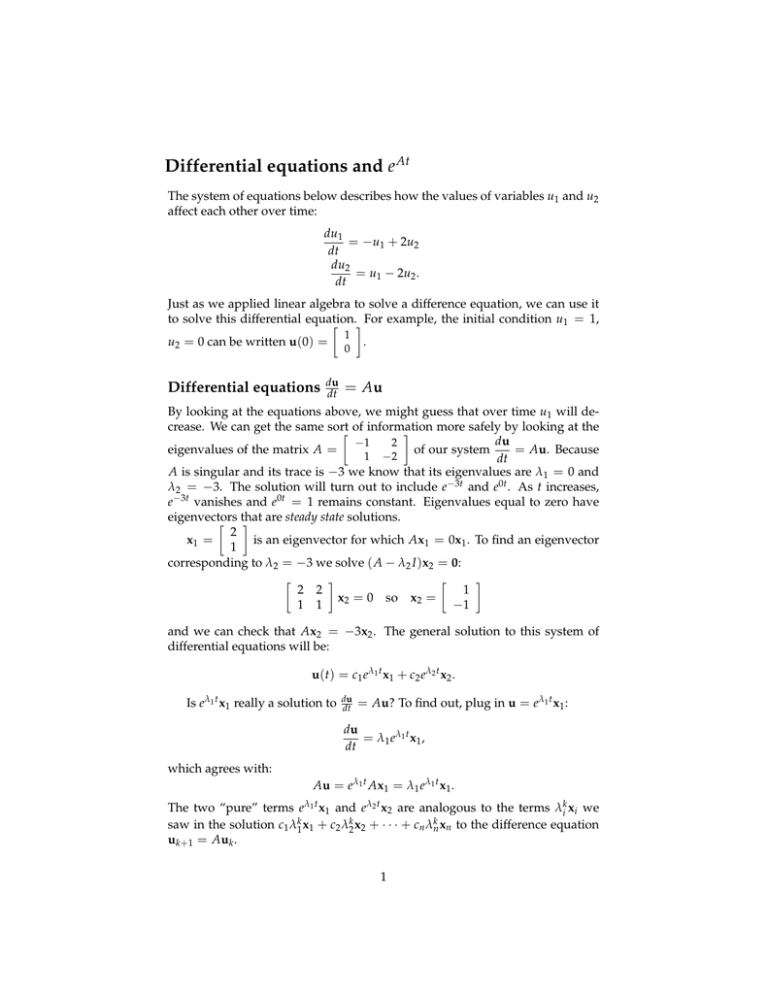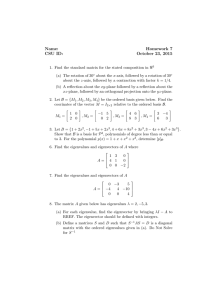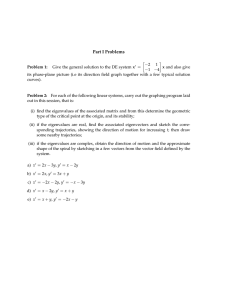Differential
advertisement

Differential equations and e At The system of equations below describes how the values of variables u1 and u2 affect each other over time: du1 = −u1 + 2u2 dt du2 = u1 − 2u2 . dt Just as we applied linear algebra to solve a difference equation, we can use it to solve this differential equation. � � For example, the initial condition u1 = 1, u2 = 0 can be written u(0) = Differential equations du dt 1 0 . = Au By looking at the equations above, we might guess that over time u1 will de­ crease. We can get the same sort more safely by looking at the � of information � du −1 2 eigenvalues of the matrix A = of our system = Au. Because 1 −2 dt A is singular and its trace is −3 we know that its eigenvalues are λ1 = 0 and λ2 = −3. The solution will turn out to include e−3t and e0t . As t increases, e−3t vanishes and e0t = 1 remains constant. Eigenvalues equal to zero have eigenvectors � that � are steady state solutions. 2 x1 = is an eigenvector for which Ax1 = 0x1 . To find an eigenvector 1 corresponding to λ2 = −3 we solve ( A − λ2 I )x2 = 0: � � � � 2 2 1 x2 = 0 so x2 = 1 1 −1 and we can check that Ax2 = −3x2 . The general solution to this system of differential equations will be: u ( t ) = c 1 e λ1 t x 1 + c 2 e λ2 t x 2 . Is eλ1 t x1 really a solution to du dt = Au? To find out, plug in u = eλ1 t x1 : du = λ 1 e λ1 t x 1 , dt which agrees with: Au = eλ1 t Ax1 = λ1 eλ1 t x1 . The two “pure” terms eλ1 t x1 and eλ2 t x2 are analogous to the terms λik xi we saw in the solution c1 λ1k x1 + c2 λ2k x2 + · · · + cn λkn xn to the difference equation uk+1 = Auk . 1 Plugging in the values of the eigenvectors, we get: � � � � 2 1 λ1 t λ2 t −3t u ( t ) = c1 e x1 + c2 e x2 = c1 + c2 e . 1 −1 � � 1 We know u(0) = , so at t = 0: 0 � � 1 = c1 + c2 . −1 � � � � 2 1 c1 = c2 = 1/3 and u(t) = 13 + 13 e−3t . 1 −1 This tells us that the system starts with u1 = 1 and u2 = 0 but that as t approaches infinity, u1 decays to 2/3 and u2 increases to 1/3. This might describe stuff moving from u1 to u2 . � � 1 0 � � 2 1 � � The steady state of this system is u(∞) = 2/3 1/3 . Stability Not all systems have a steady state. The eigenvalues of A will tell us what sort of solutions to expect: 1. Stability: u(t) → 0 when Re(λ) < 0. 2. Steady state: One eigenvalue is 0 and all other eigenvalues have negative real part. 3. Blow up: if Re(λ) > 0 for any eigenvalue λ. � � a b If a two by two matrix A = has two eigenvalues with negative c d � � −2 0 real part, its trace a + d is negative. The converse is not true: has 0 1 negative trace but one of its eigenvalues is 1 and e1t blows up. If A has a positive determinant and negative trace then the corresponding solutions must be stable. Applying S The final step of our solution to the system ddtu = Au was to solve: � � � � � � 2 1 1 c1 + c2 = . 1 −1 0 In matrix form: � 2 1 1 −1 �� c1 c2 2 � � = 1 0 � . or Sc = u(0), where S is the eigenvector matrix. The components of c deter­ mine the contribution from each pure exponential solution, based on the initial conditions of the system. In the equation ddtu = Au, the matrix A couples the pure solutions. We set u = Sv, where S is the matrix of eigenvectors of A, to get: S or: dv = ASv dt dv = S−1 ASv = Λv. dt This diagonalizes the system: dvi dt = λi vi . The general solution is then: = eΛt v(0), v(t) Λt −1 u(t) = Se S and v(0) = e At u(0). Matrix exponential e At What does e At mean if A is a matrix? We know that for a real number x, ex = ∞ ∑ n =0 xn x2 x3 = 1+x+ + + · · · . n! 2 6 We can use the same formula to define e At : e At = I + At + ( At)2 ( At)3 + +··· . 2 6 Similarly, if the eigenvalues of At are small, we can use the geometric series ∞ 1 = ∑ x n to estimate ( I − At)−1 = I + At + ( At)2 + ( At)3 + · · · . 1−x n =0 We’ve said that e At = SeΛt S−1 . If A has n independent eigenvectors we can prove this from the definition of e At by using the formula A = SΛS−1 : e At ( At)2 ( At)3 + +··· 2 6 SΛ2 S−1 2 SΛ3 S−1 3 = SS−1 + SΛS−1 t + t + t +··· 2 6 = SeΛt S−1 . = I + At + It’s impractical to add up infinitely many matrices. Fortunately, there is an easier way to compute eΛt . Remember that: ⎡ ⎤ λ1 0 ··· 0 ⎢ 0 λ2 0 ⎥ ⎢ ⎥ Λ=⎢ . .. ⎥ . . .. ⎣ .. . ⎦ 0 ··· 0 λn 3 When we plug this in to our formula for e At we find that: ⎡ ⎢ ⎢ eΛt = ⎢ ⎣ e λ1 t 0 .. . e λ2 t 0 ··· 0 ··· 0 0 .. . .. . 0 ⎤ ⎥ ⎥ ⎥. ⎦ eλn t This is another way to see the relationship between the stability of u(t) = SeΛt S−1 v(0) and the eigenvalues of A. Second order We can change the second order equation y�� + by� + ky = 0 into a two by two first order system using a method �similar � to the one we used to find a formula y� y for the Fibonacci numbers. If u = u� = � y�� y� � � = , then −b 1 −k 0 �� y� y � . We could use the methods we just learned to solve this system, and that would give us a solution to the second order scalar equation we started with. If we start with a kth order equation we get a k by k matrix with coefficients of the equation in the first row and 1’s on a diagonal below that; the rest of the entries are 0. 4 MIT OpenCourseWare http://ocw.mit.edu 18.06SC Linear Algebra Fall 2011 For information about citing these materials or our Terms of Use, visit: http://ocw.mit.edu/terms.







